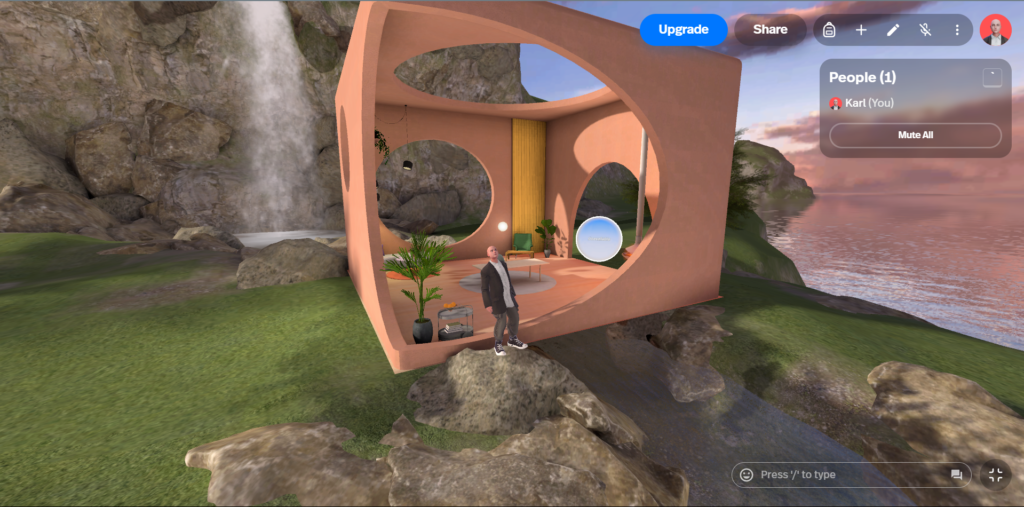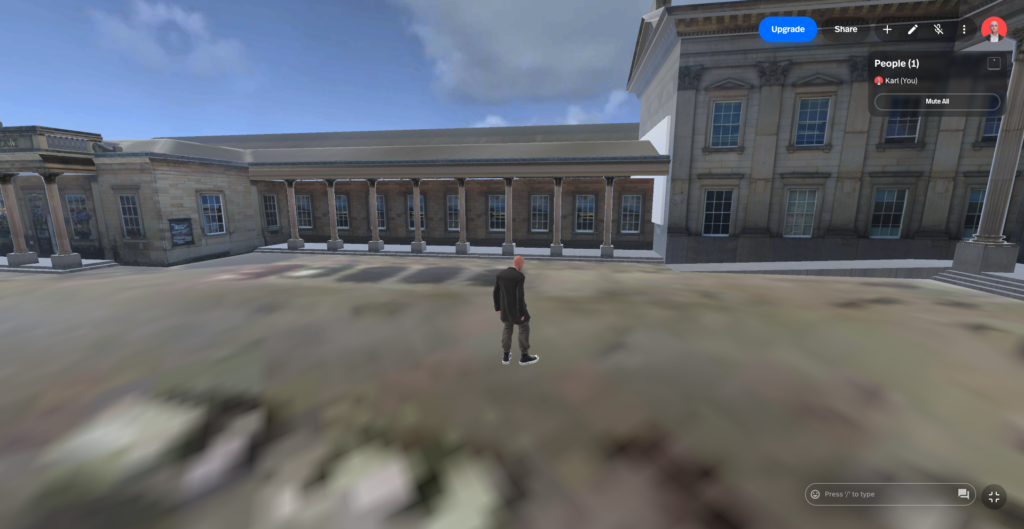
Spatial is a developing platform that, on the surface, seems to be a metaverse app for hosting VR spaces with multiple users – though it’s one with several unique factors (in the current climate). While other metaverse apps focus on the social first, Spatial Focuses on space first. Rather than carving out your own areas in shared spaces, Spatial allows you to create individual spaces that can then be shared with anyone, whether they are members of the platform or not. It runs on the Oculus Quest headset but is also accessible on the web and mobile, making it easier to update spaces and “host” events.
There are three tiers of production available to creators. The first is the creation of content within the application. Like any other metaverse app, there are tools for building within environments. In the second tier, creators can upload 3D environments created with other tools in cross-platform file formats. finally, there is comprehensive integration with Unity the game engine, and design tools doc
I initiated and expanded on several projects using Spatial and various workflows.
Feelings

Firstly, unlike Horizon Worlds, Rec Room, VR Chat and others, Spatial is not “public by default”.Rather than entering a unified network of worlds, the focus is on hosting spaces (and the subsequent potential monetisation of that). Yes, players can navigate through public worlds – like Horizon and Rec Room – but the focus is on building, hosting and inviting users.
Second, creators can choose to use built-in tools (as they also can in Horizon Worlds or Rec Room) and rapidly create spaces using primitive shapes. They can connect to built-in assets and download furniture and other elements to populate these spaces. Creators can also create worlds from templates with unique properties. For example, I quickly created a VR exhibition space using a template that included special image objects that enabled interaction with the embedded data within them. Third, there are distinct building workflows that support interoperability with other 3D creation tools. Users can connect to SketchFab and download assets directly from there. This creates a direct workflow route from asset collection in the real world via photogrammetry (PolyCam) to SketchFab into Spatial. This enables objects or even whole spaces to be quickly imported. Fourth, most interestingly (and stepping up a notch), it’s possible to import models in GLB and other interoperable 3D file formats, which enables SketchUp designs to be brought into Spatial (which is how I was able to directly import an Abbey Road model I’d designed). GLB models can also be uploaded as “environments”—so a space modelled in another tool or found in an archive can be added to a VR space.
Finally, a feature I have not explored fully, Spatial includes access to a “Spatial Creators Toolkit” that enables users to develop spaces in Unity and import them into Spatial for hosting online, with advanced features and scripting.
Evaluation
While other metaverse apps and apps allow individuals to create and share spaces, what attracted me to Spatial was the low barrier to entry for the free product and its intelligent scaling. It is entirely free to create as many spaces as one wishes; the limitation is on the number of people who can inhabit a space at a given time. This places the freemium barrier on the number of contiguous users rather than creativity, making it an ideal sandbox for experimentation and sharing potential immersive journalism artefacts. Additionally, it offers an impressive range of support for interactive elements. Initially positioned as a shared workspace tool, it became a shared gaming tool. Like other new apps, Spatial may have uncertain reach and popularity and may not be around for long, but for the moment, it is an up-and-coming tool for developing and deploying VR environments at scale and at a low cost.
Application
Through project experimentation, I found some features for Spatial that I could not find on other platforms. Firstly, it is important to recognise that Spatial is a platform rather than an authoring tool, which is the best way to consider it. Its superior interoperability with three of the best development and hosting platforms for 3D models makes it such a good choice for rapid environment development, and storytelling is supported through Unity’s interactive creation tools.
The main project I could transfer was my Abbey Road Studio 2 environment. With a little editing, it was instantly transformed into a VR environment I could visit. After spending several weeks creating it in SketchUp, I found this to be a breakthrough moment. I added interactivity to chairs within the location so that specific, fixed viewpoints were within the scene. All of this was point-and-click. In summary, if we already have a 3D space in an interoperable format, it can be uploaded to Spatial, viewpoints added, media added, and a story assembled very quickly.
Secondly, because Spatial supports cross-platform 3D model formats, we can do two things with photogrammetry. We can capture spaces and upload those to Spatial, transforming them immediately into VR environments. I did this with a photographically captured Stonehenge. This was processed into 3D space from drone footage using PolyCam and turned into an environment I could walk around. Furthermore, its integration with Sketchfab means that we can photogrammetrically capture objects and place them within environments, and these objects, in turn, can attach interactivity to them. This functionality is available without programming; however, Unity could be used as an intermediary stage to apply more sophisticated interactive functionality.
Conclusions
At some point in the future, if immersive journalism is to be anything more than another fad, there must be some type of distribution platform that readers can use to consume content. Just as in the streaming age, we can open Amazon Prime Video or Netflix, but VR will need its own platform. Current options resembling this model include metaverse platforms, but are the environmental design and authoring tools of those platforms suitable for developing immersive journalism? Are the social tools of those platforms superfluous?
Consuming narrative material along a critical story path is an individual activity. Let’s compare single-player games and multiplayer games here. For example, the single-player version of Quake is a linear experience for the player facing progressive tasks and scenarios. In contrast, the multiplayer version of Quake is a chaotic free-for-all deathmatch with players jumping around maps, shooting at each other, and competing to be the last player standing. That’s why Spatial is already ahead of platforms like Rec Room, Horizon Worlds, and VRChat in one sense. It has comparable or superior VR authoring tools without the baggage of social or multiplayer requirements. However, it doesn’t have the backing of a major sponsor like Facebook or Google. Until it does, it will be vulnerable to closure, given current circumstances and the number of platforms and tools that have already shut down.